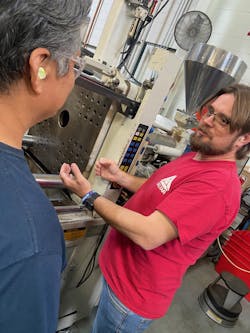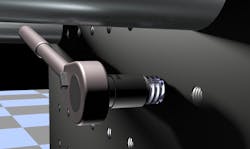Problem: Stripped bolt holes made hanging molds from platens a tricky, potentially dangerous job for a maker of parts for the military and automotive industry.
Solution: Specially designed steel inserts installed in the bolt holes provide a secure port for mounting molds.
By Karen Hanna
Molder ITW Deltar Fasteners performs numerous changeovers every day, so it’s sensitive to the kinds of tasks that can create hurdles from one job to the next.
One such hang-up would be familiar to anyone who’s ever tried to turn a screw into a hole after the hole’s distinctive ridges have worn away.
For years, ITW, based in Troy, Mich., has sought ways to deal with stripped bolt-hole threads on the platens of its 110 injection molding machines (IMMs) at plants in Frankfort, Ill., and Chippewa Falls, Wis. Its 380 employees — including about 130 in Frankfort — make fasteners, hole plugs, bumpers and baffles for the automotive industry and the military, process engineer Kenny Dearing said.
“Damage can occur if the wrong size bolt is installed into the hole, or if too long or short of a bolt with the correct thread is installed,” Dearing said.
One fix is particularly expensive: “Replacing platens could be a potential alternative to repairing,” he said.
Products to repair the holes have proved inadequate, or wore out over time. They “were difficult to install, and we did not have a lot of faith in them. They would rip out,” he said.
The Frankfort plant alone performs 10 to 20 mold changes a day, including two or three on a 1995 150-ton Toyo, which, as of July, had undergone more than 250 mold changes this year. Around the middle range of the machines ITW operates — the molder also runs Shibauras, Sumitomos, Cincinnati Milacrons and Nisseis ranging from 85 tons to 330 tons — the machine has large and lengthy clamps and clamp bolts for mold installations.
“I knew we needed a permanent solution to repair these bolt holes to make mold installation quick, easy and safe,” Dearing said.
The answer came in the form of inserts from C-Sert, which also supplied repair kits, with cutting bits to open stripped holes, oil for the bits and bits to use to install the inserts into the platen.
According to their manufacturer’s website, the inserts — also known as C-Serts — come in S-7 tool steel that’s through-hardened to a Rockwell hardness of 56.
Once installed, left-handed engagement threads prevent the inserts from coming loose when bolts inserted in them are removed. To prevent the possibility of future damage, the inserts’ threads have an especially robust profile of lands and flights.
“We work with molders almost every day,” C-Sert owner Carl Strom said. “The cost to molders of damaged platen threads is, of course, lost production/out-of-service time, and occasionally — in the case of automotive molders — penalty clauses for late production. A second, rarer but catastrophic cost is safety-related, when a mold breaks loose and damages the press or injures or kills an operator or maintenance tech. C-Serts prevent this.”
The products are especially useful to molders and mold makers interested in addressing stripped holes in platens, he said.
While its products attract demand from plants representing a number of industries, including steel mills, paper mills, cement plants and petrochemical factories, C-Sert filled its biggest order for a company facing the same challenges as ITW, Strom said.
He recalled: “Our largest order ever resulted from such a platen failure, thanks to the company’s chief safety officer and its insurer.”
C-Sert offers a lifetime warranty with its inserts, saying parenthetically on its website, “When no one else will give you even a 1 day guarantee. …”
Based on ITW’s experience, C-Sert's confidence in its inserts is a credit to their performance.
“They are a quick and sustainable solution to the issue of stripped bolt holes,” Dearing said, and, unlike the bolt holes themselves, they can’t be stripped.
ITW first tried the inserts on its Toyo in August 2020. It took less than 90 minutes to plug them into four badly damaged holes.
“The C-Serts are installed by using a drill to clear out the damaged threaded hole, and an insert is installed via integrated cutters into the old hole’s place,” Dearing said.
According to C-Sert, after expanding the stripped bolt hole to make room for a new insert, users tap the insert into place. The grooves on the insert cut straight into the structure where it’s installed, ensuring a tight fit that requires no glue or mechanical aids — which could eventually fail.
C-Serts can be used to repair bolts with diameters and thread pitch of any size. The company maintains an inventory of a range of sizes, with dimensions that can account for presses with clamping forces up to 4,000 tons, Strom said.
Since tapping the first insert into the platens of the 150-ton Toyo, ITW has used the inserts on a variety of sizes of platens on 20 machines.
The inserts, Dearing said, are “very easy to use with some common sense and a working knowledge of hand tools.”
With them, platen maintenance and changeovers are much easier.
Stripped threads meant hanging molds was often a lengthy task, but now, what once took 15 minutes takes 5 minutes, because the holes are fixed, Dearing said.
“We have a safer and more productive workspace because bolt holes that weren’t working have been restored, enabling us to use the correct mold clamps in the correct positions to mount molds — as opposed to grabbing a corner of the mold,” he said. “We don’t want ‘good enough’ here — we need to always use proper procedures for mold mounting.”
Karen Hanna, senior staff reporter
Contact:
C-Sert Manufacturing, Portland, Ore., 971-347-3185, www.c-sert.com/contact
About the Author
Karen Hanna
Senior Staff Reporter
Senior Staff Reporter Karen Hanna covers injection molding, molds and tooling, processors, workforce and other topics, and writes features including In Other Words and Problem Solved for Plastics Machinery & Manufacturing, Plastics Recycling and The Journal of Blow Molding. She has more than 15 years of experience in daily and magazine journalism.


